Learn how to make lilac jelly in the first moments of true spring, when lilacs have their short and beautiful bloom! Lilacs are indeed edible, so if you are in search of lilac recipes this is a great one to make this season.
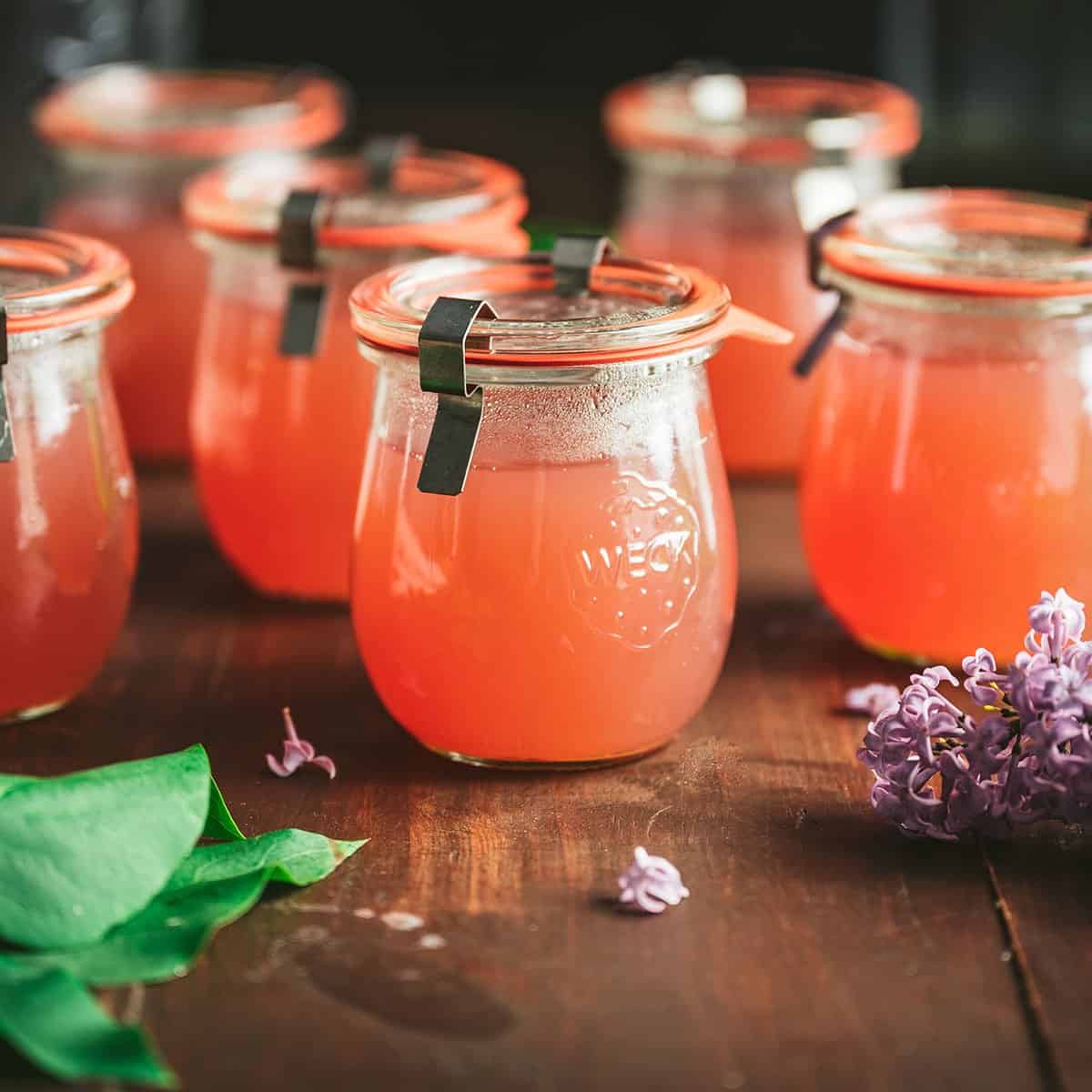
Want to save this post for later?
Low-Sugar Flower Jelly
This lovely flower jelly is low in sugar and has an amazing light floral taste. This simple jelly is a perfect way to celebrate spring and preserve all of the beauty of these edible and beneficial blossoms!
Lilac flowers are edible, and have a floral taste that gives spring with every bite. Any color of lilacs are okay to use in this low-sugar jelly.
Dark purple lilacs will lead to a more saturated natural color in the lilac tea and jelly. White or light purple blossoms make a yellow or khaki color jelly, but don’t fret! Add a few blueberries in and it will look beautiful without sacrificing the floral flavor.
I love to make low-sugar jellies, especially flower jellies! Dandelion jelly has a sunny honey flavor, lavender jelly has a sweet and bright flavor, and violet jelly adds lovely color and a berry flavor to your toast.
Lilac jelly is a wonderful way to capture the essence and color of lilacs. It’s a delicious way to enjoy these fragrant edible flowers, they’re one of the first signs of true spring!
Lilac mead and herbal syrup are other wonderful ways to use these aromatic blooms this spring!
Get recipes using wild violet, lilac, forsythia, chive, calendula, lavender, white clover, nasturtium, elderflower, yarrow, rose, and Queen Anne’s lace flowers in my ebook Edible Flower Recipes: Infusions, Syrups, Jellies, Beverages, & Snacks!
Low Sugar Lilac Jelly Recipe
Lilac jelly is one of the easiest floral jellies to make because their bloom is abundant, if short. 5 to 6 large lilac flower clusters are all that is needed, so your backyard tree is a perfect bet!
When foraging fresh lilacs, make sure they are gathered in a place that is not sprayed with harmful chemicals or growing in high-traffic areas like a busy roadside.
If you don’t grow lilacs, ask a neighbor or friend. They’re popular for their beautiful look and amazing smell, someone you know is sure to have some! Act fast, their blooming time is limited.
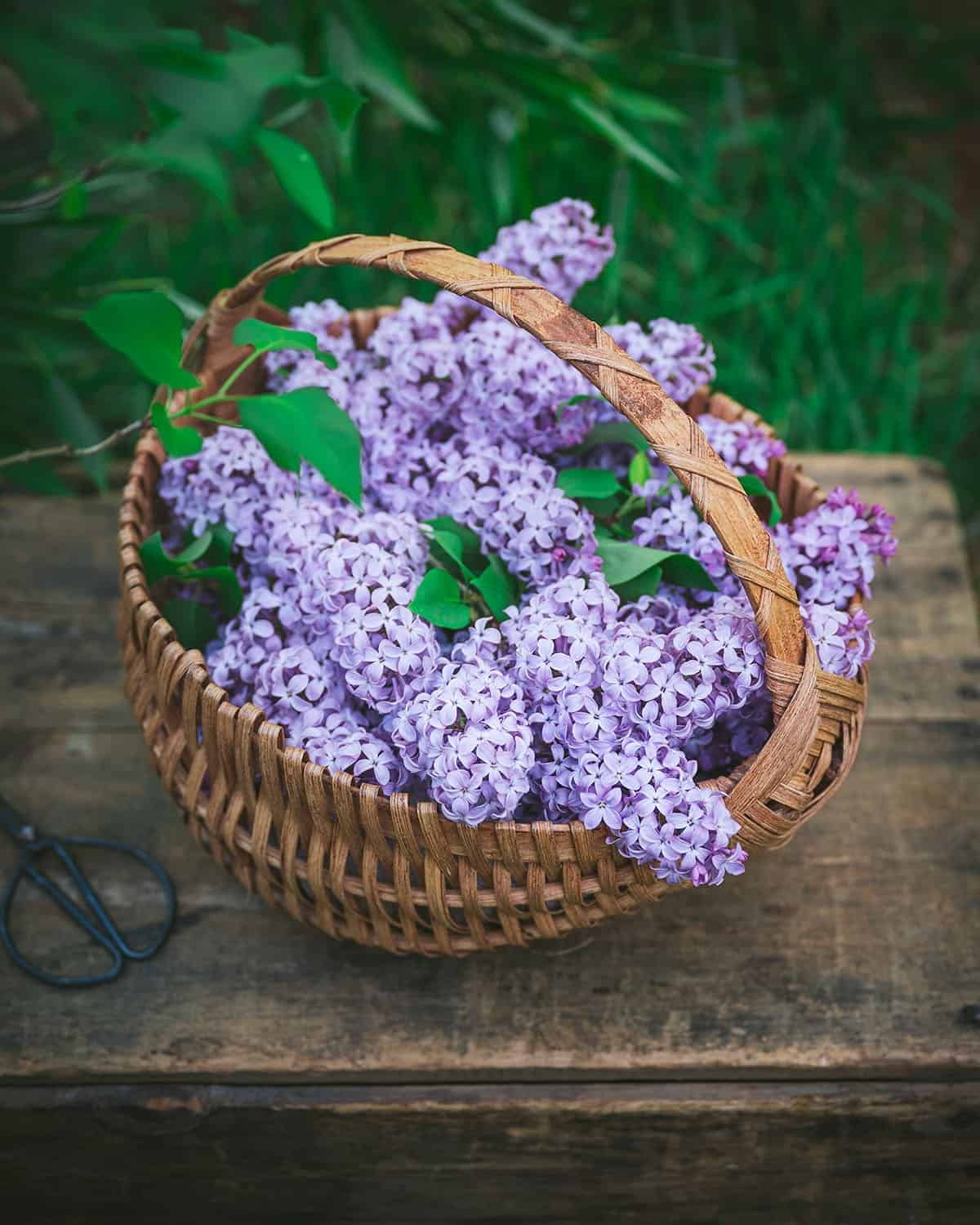
All you need to do is separate the flowers from the stems, and before you know it, you’ll have a beautiful jar full of lilac blossoms, ready for jelly!
I love low-sugar lilac jelly because it allows the fragrant taste and scent of the lilacs to shine through in this unique flower jelly recipe!
Ingredients
Lilac flowers: Grab a few clusters up when they bloom, and take a few minutes to pick the flowers off. A little bit of stem isn’t harmful, but keep it to a minimum so it doesn’t impact the flavor.
I’ve heard of people using frozen flower blossoms to make jelly later; I haven’t tried that, so I’m not sure how well it would work. It’s best to make this easy recipe while the flowers are fresh!
Frozen blueberries: This is optional but recommended, especially with the use of white or light purple lilac flowers. It adds just the right amount of natural color to match the floral taste!
Pomona’s Pectin: This lilac jelly recipe works well with low-sugar pectins. Pomona’s Universal Pectin reacts with calcium water instead of sugar, so low amounts of any kind of sweetener can be used to sweeten the taste of the jelly.
Note: The calcium powder comes in the box with Pomona’s Universal Pectin, so there is no need to purchase any separately.
Lemon juice: I like to use freshly squeezed, but use what you have on hand.
Sugar: If you prefer not to use traditional cane sugar, you could instead use honey, coconut sugar, or another sugar substitute in its place.
Note: Sugar helps the jelly set, so without cane sugar, you may get a softer consistency. Keep this in mind when choosing a sweetener to use.
Related: try this no sugar apple jelly or this no sugar peach jam!
How to Make Lilac Flower Jelly
The first part of this jelly recipe is to make lilac tea with fresh lilac flowers. Gather 5-6 lilac flower heads and rinse if needed, then pick the petals from the stems by hand or with scissors.
4 cups of loosely packed freshly picked lilac flowers are needed per one batch of jelly.
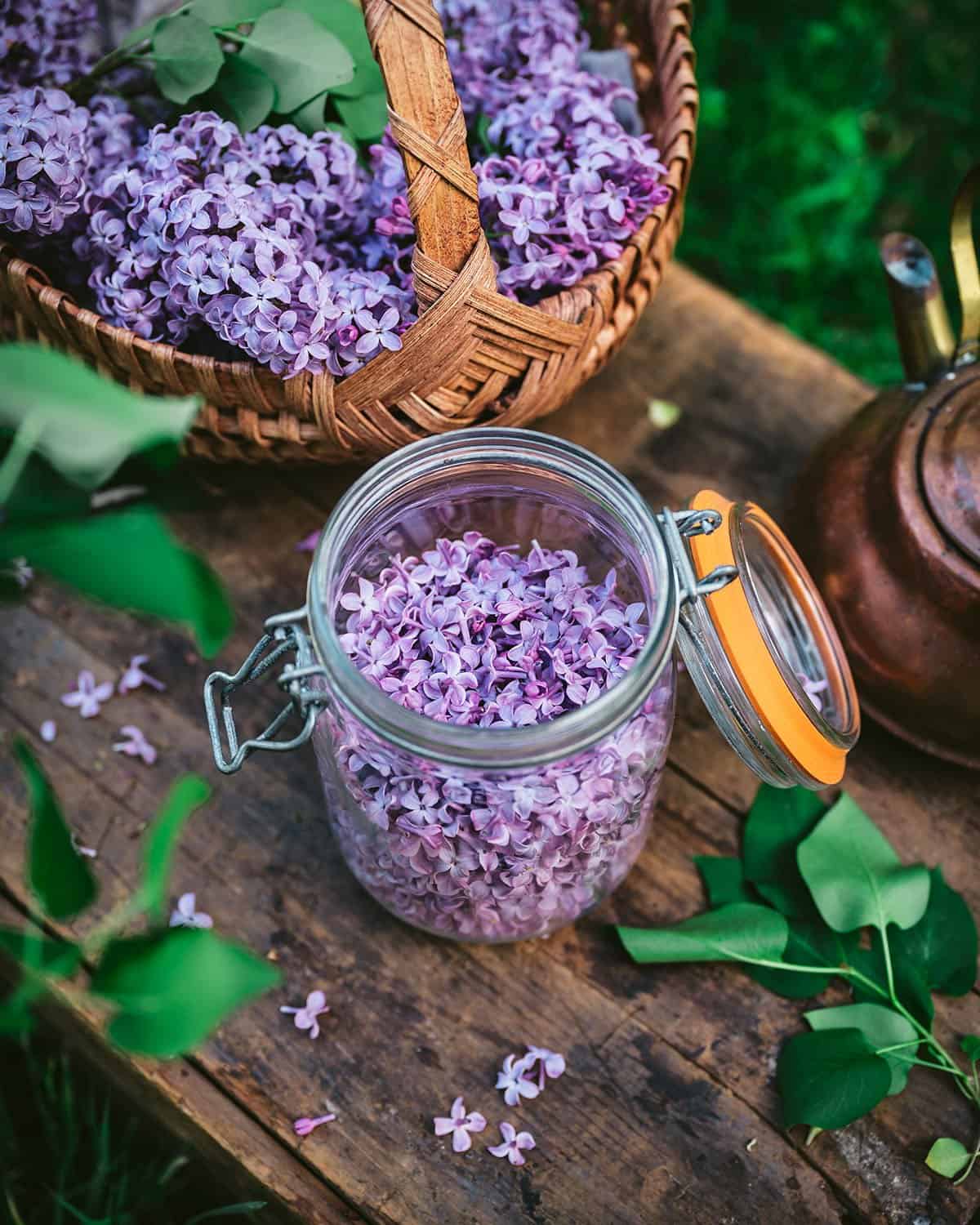
Then, place the lilacs in a heat-safe quart jar. To enhance the purple color of the jelly, add 5-6 frozen blueberries or blackberries in the jar to steep with the tea. Then pour boiling water over the flowers.
As you pour the boiling water over the lilacs, you will notice that the flowers will lose their color, and the water will turn bluish-green (or pink-purple if you add the berries).
Once the lemon juice is added, it will change to bright pink!
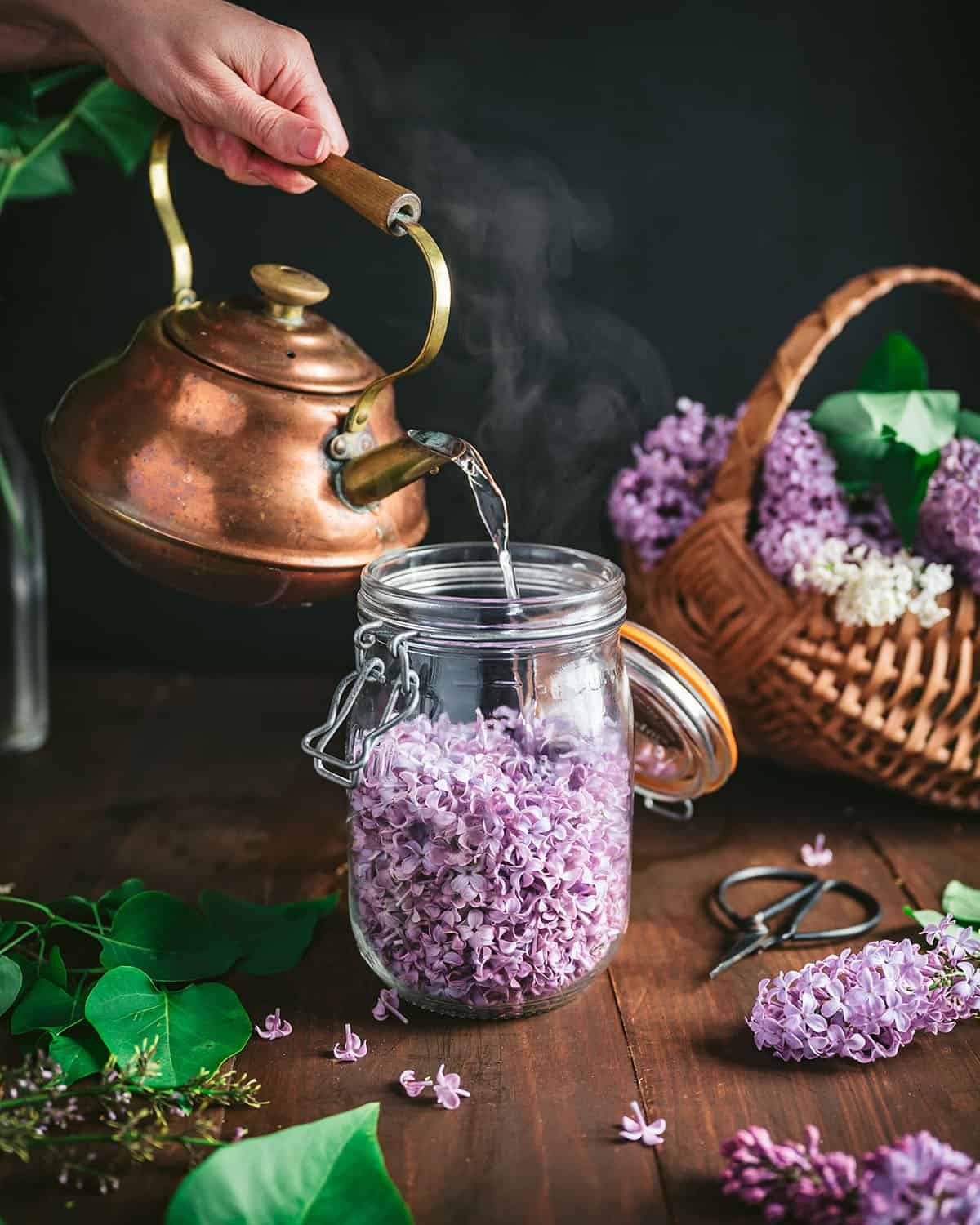
Note: Make sure the water is at a full boil when you pour it over the lilacs. Any cooler will make the tea smell slightly spoiled, and the flowers won’t release their color.
Cover the jar and allow the tea to cool to room temperature on the counter. Then, place it in the refrigerator and let it steep for 8 hours or overnight, no longer than 24 hours.
Then, use a fine-mesh strainer or cheesecloth to strain the lilac flowers out of the tea. Compost the spent lilacs.
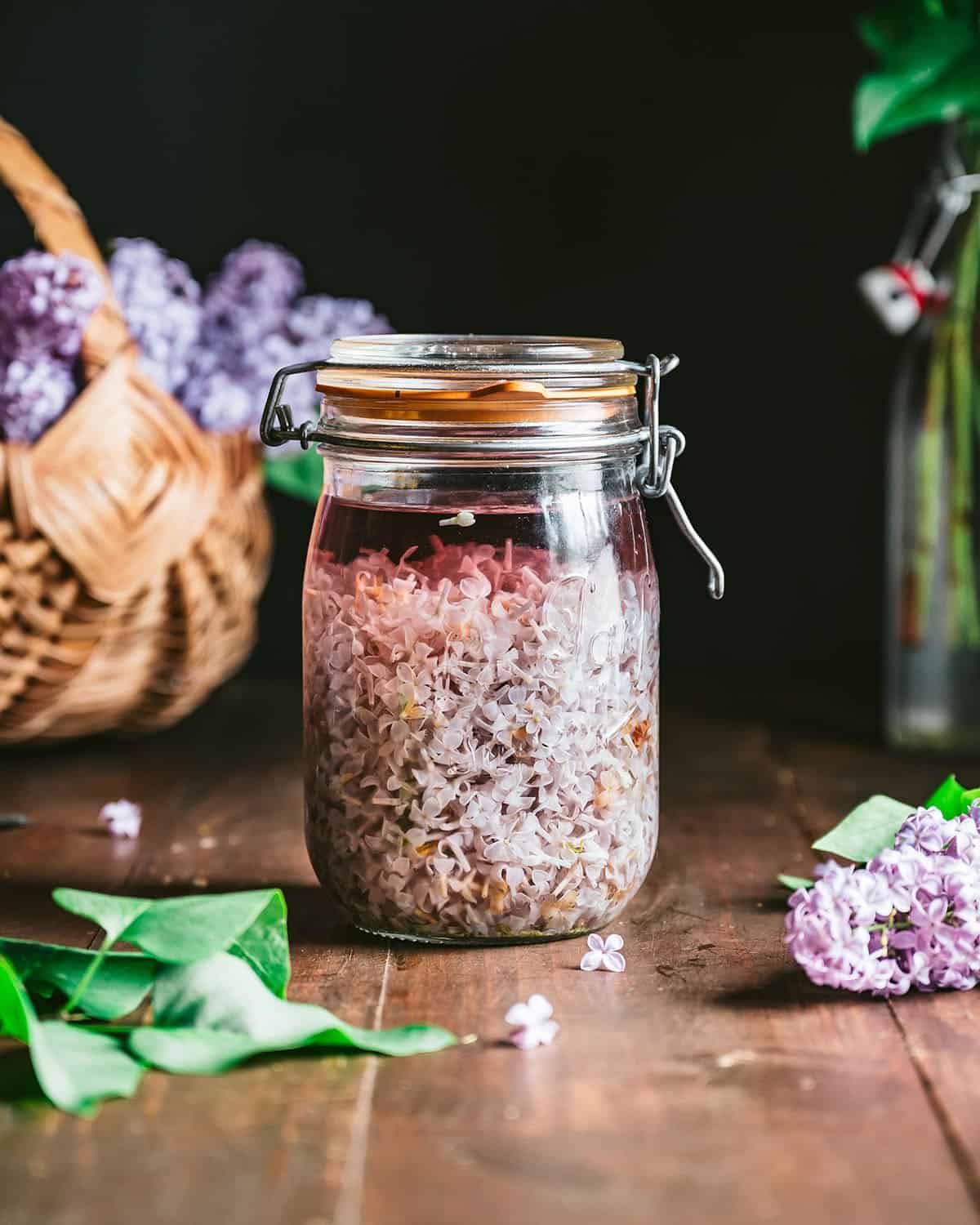
Prepare For Canning
First, before you begin, prepare the calcium water by combining 1/2 teaspoon calcium powder with 1/2 cup water in a small jar and shake well. Any unused calcium water can be stored in the fridge for future use.
Then wash the jars, lids, and bands. Place the jars in a large pot with enough water to cover them, and bring to a boil. Once boiling, turn the heat off and keep the jars in the hot water until ready to use.
The lids and bands can be covered with water set to a low boil in a smaller saucepan. Once boiling, turn the heat off and keep the lids and bands in the hot water until ready to use.
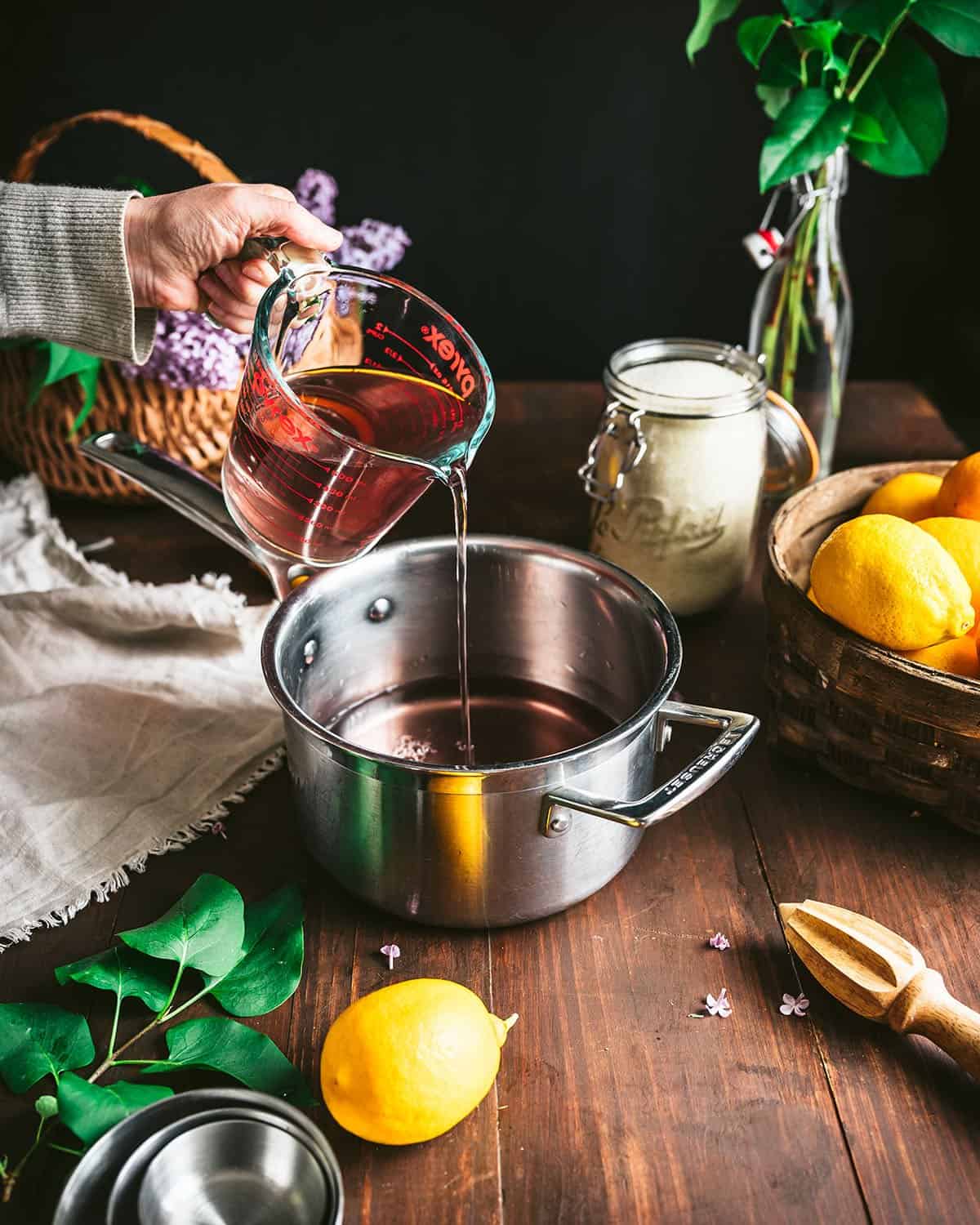
Cook the Jelly
Pour 4 cups of lilac tea (adding a little water if necessary to measure up) into a medium saucepan. Add the calcium water and lemon juice, and mix well.
In a small bowl, mix together the sugar and pectin. Stir to combine thoroughly and set aside.
Heat the saucepan with the tea jelly mixture until it comes to a full boil. Add the pectin-sugar mixture and stir vigorously until the jelly comes back up to a boil.
Once the jelly comes back to a full boil, remove it from the heat.
Process for Canning
Fill the hot jars with the jelly mixture, leaving about a 1/4 inch space at the top. Wipe the rims clean and pop bubbles as necessary.
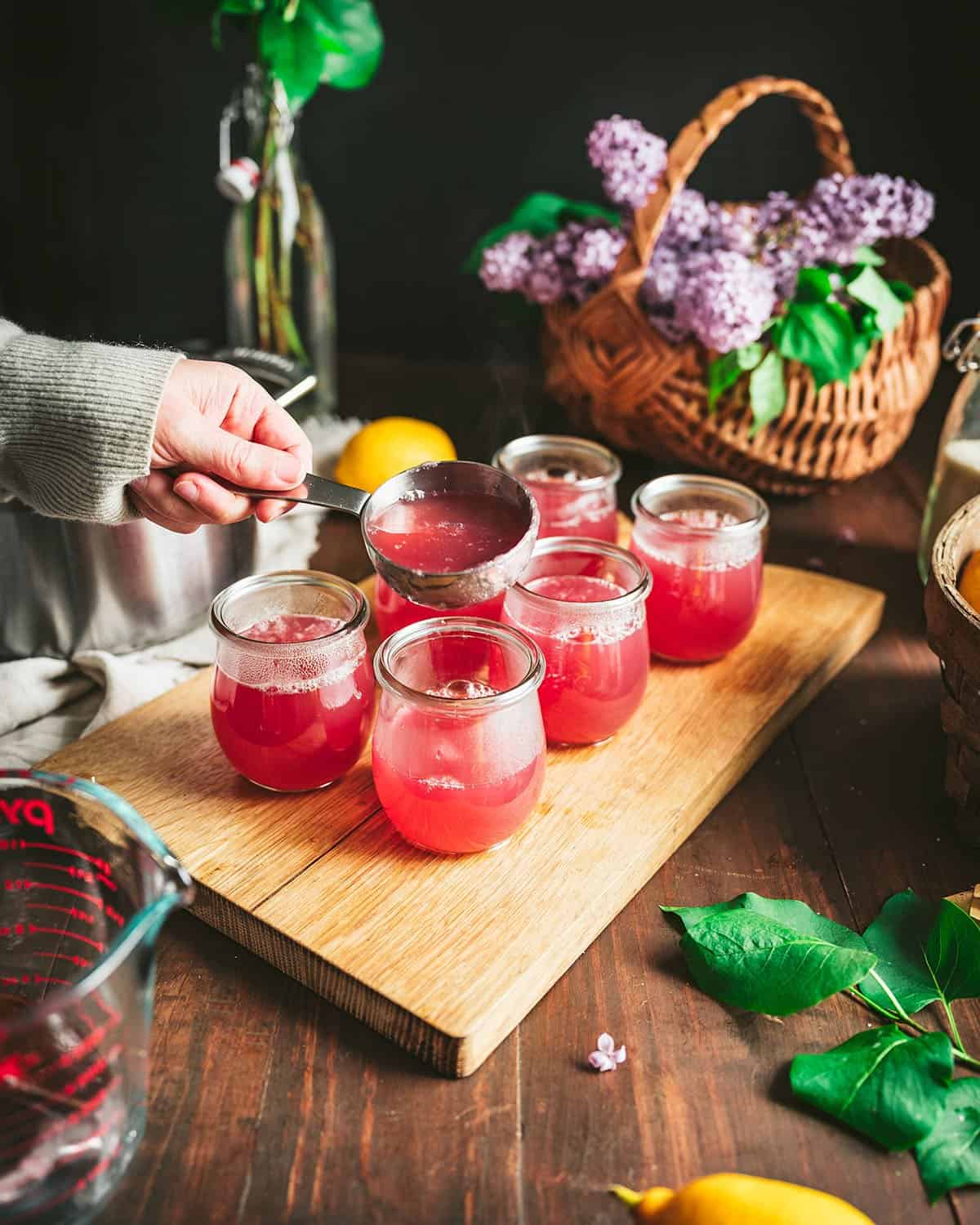
Place the filled jars in boiling water that completely covers the jars. Cover the pot and process for 10 minutes (add 1 minute for every 1,000 feet above sea level).
Remove from the water bath and let the jars cool, then check the seals. Now you can enjoy the fragrant flavor of lilac jelly anytime you need a little bit of spring magic in your life!
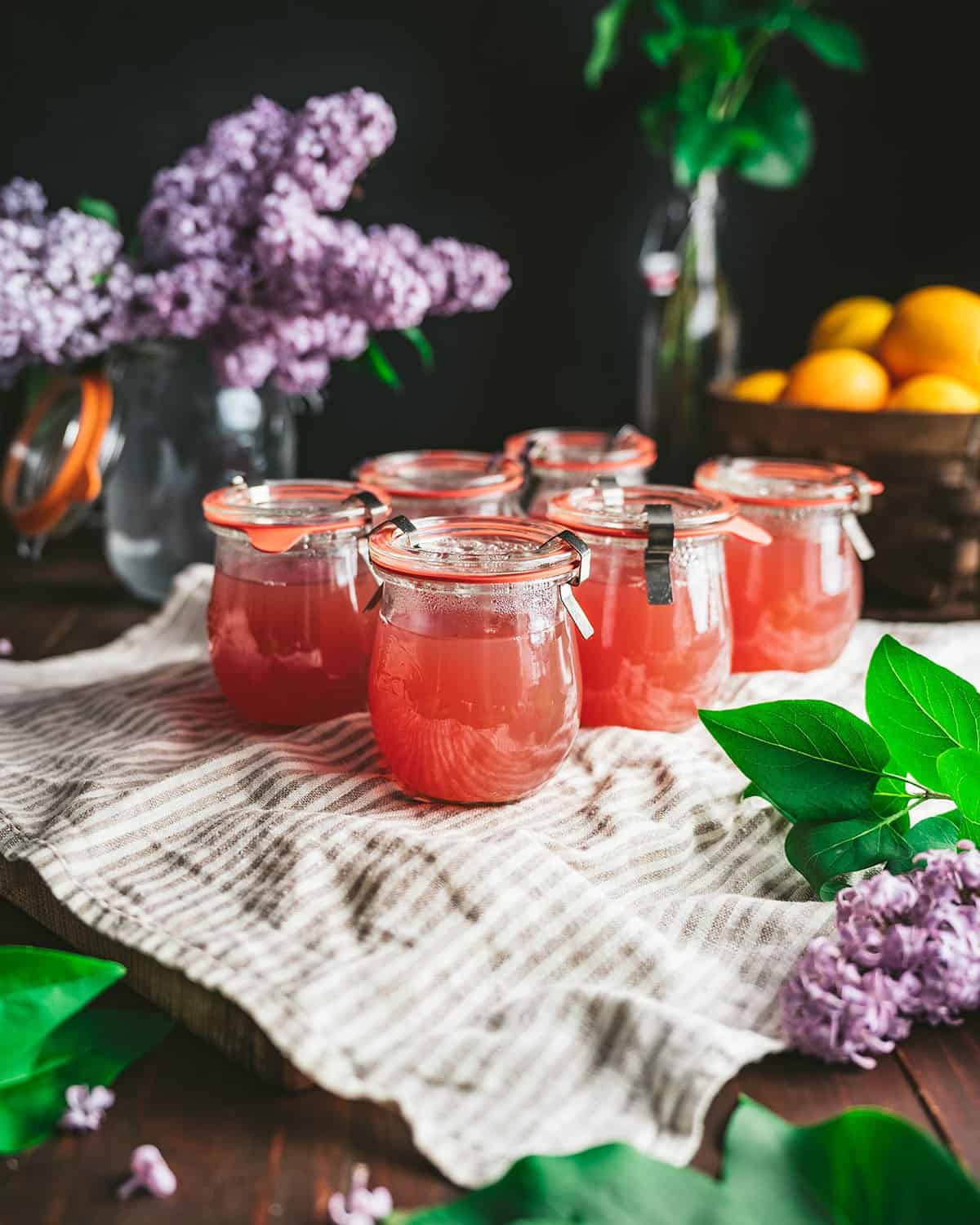
What Color is Lilac Jelly?
Since lilacs are purple, one might expect a purple jelly! However, in reality, light purple lilacs result in a tan/yellow jelly.
When you pour the boiling water over the fresh lilac flowers, the steeped tea liquid is a bluish-green color that changes to pink when you add the lemon juice due to the change in pH.
Once processed, it will turn to a light tan or yellow color. It will still taste just as good, but doesn’t have the bright spring vibe it started with.
To turn the lilac tea into a beautiful purple color that turns raspberry pink when the lemon juice is added, add 5-6 frozen blueberries or blackberries to the flowers before steeping.
The jelly will then be a bright raspberry pink after cooking but will fade a little when canned in the water bath. It ends up a delicate and beautiful light pink color perfect for spring.
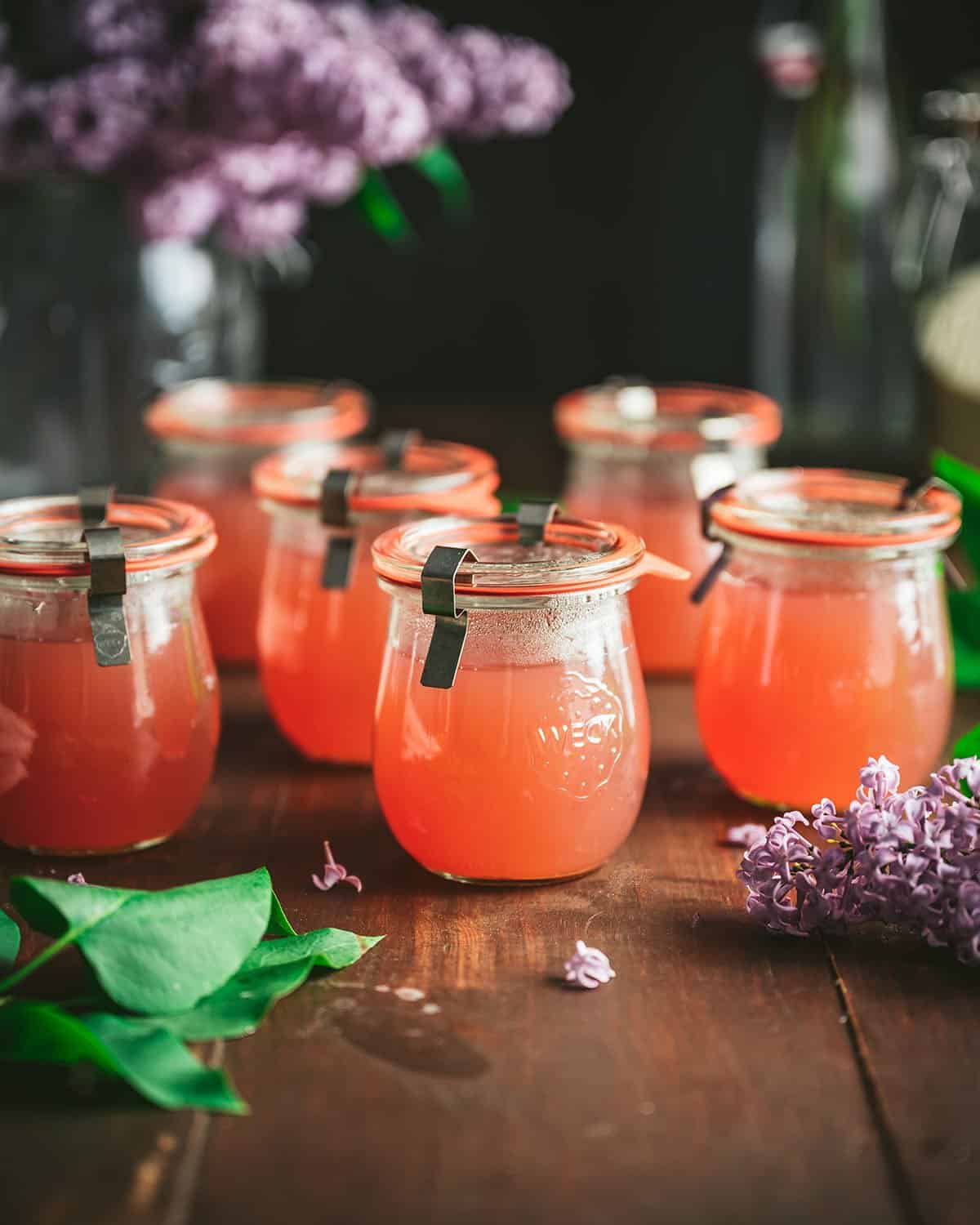
Storing Lilac Flower Jelly
Lilac jelly can be stored for up to a year and, once opened, will last three weeks in the refrigerator. You’ll be so glad you have this burst of floral spring flavor waiting for you whenever you have a craving!
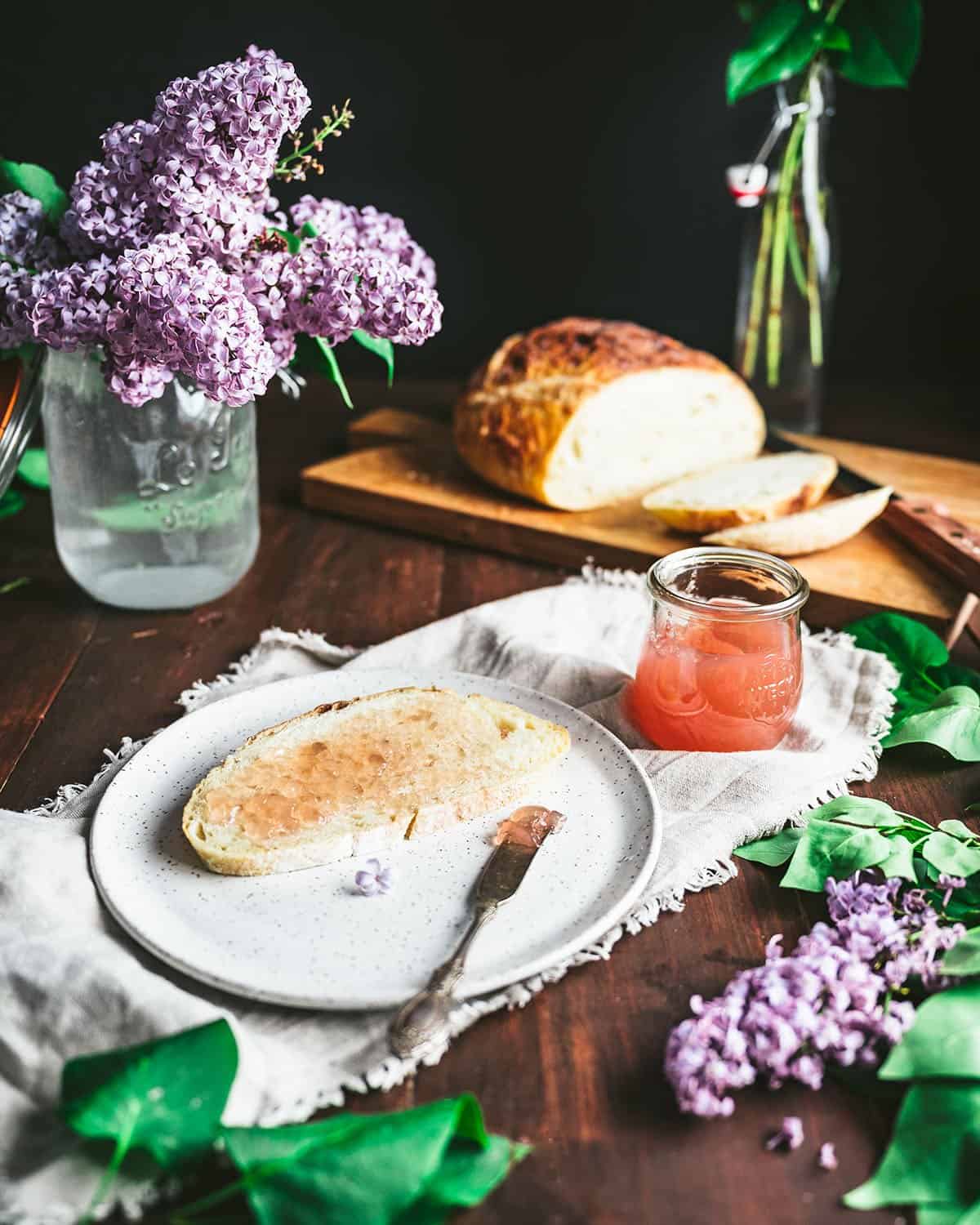
This flower jelly is delicious on buttered toast, with crackers and cream cheese, or topped on vanilla ice cream or yogurt.
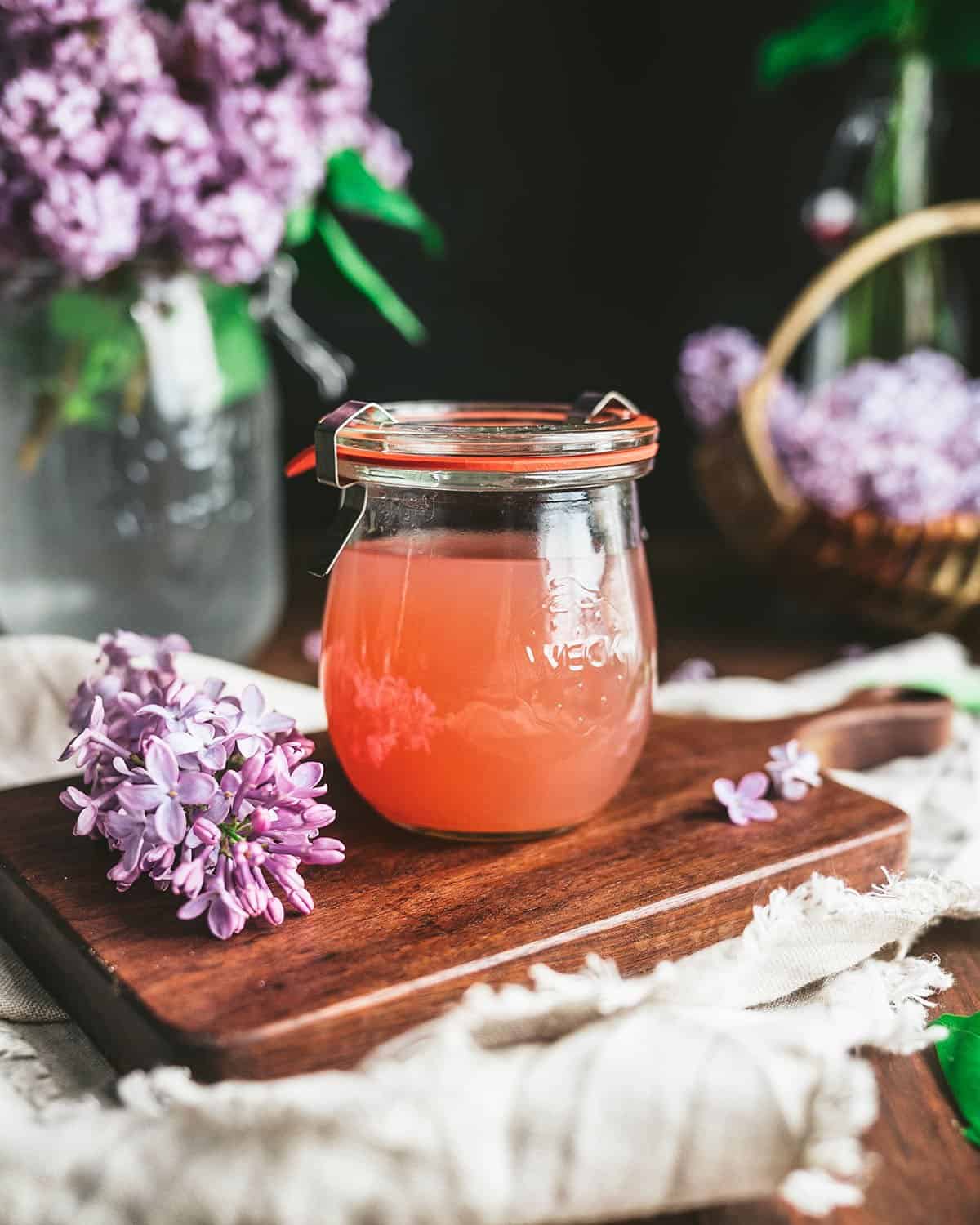
More Edible Flower Recipes
- Lilac Flower Infused Honey
- Lilac Mead: Floral Honey Wine
- Wild Violet Flower Infused Vinegar
- Forsythia Flower Honey Syrup
- Nasturtium Flower Infused Vinegar
More Low Sugar Jam & Jelly Recipes
- No Sugar Apple Jelly
- No Sugar Peach Jam
- Low Sugar Raspberry Jam
- Low Sugar Wild Violet Jelly
- Low Sugar Strawberry Jam
- Low Sugar Dandelion Jelly
- No Sugar Blueberry Jam
- Low Sugar Blackberry Jam
Lilac Jelly
Equipment
Ingredients
Lilac Tea
- 4 cups boiling water
- 4 cups fresh lilac flowers
- 5-6 frozen blueberries or blackberries optional
Lilac Jelly
- 1 Tbsp + ½ tsp calcium water see instructions below for more info
- ½ cup lemon juice
- 1¾ cup sugar
- 1 Tbsp + ½ tsp Pomona's Pectin
Instructions
Lilac Tea
- Wash the lilac flowers if needed, and pick the flowers by hand or with scissors to remove them from the stems. Fill about 4 cups full of blossoms.
- Place the lilacs into a heat-safe quart jar.
- Optional: Add 5-6 frozen blueberries or blackberries to make the jelly purple.
- Once you have filled your quart jar with loosely packed fresh lilac flowers, pour the boiling water over them to make the tea infusion.
- Cover the jar and allow it to cool to room temperature on the counter. Then, place it in the refrigerator and let it steep for 8 hours or overnight.
Lilac Jelly
- First, prepare the calcium water by combining ½ tsp of calcium powder (from the Pomona's Pectin package) with ½ cup water in a small jar. Shake well. Any extra calcium water can be stored in the refrigerator for future use.
- Place the jars in a large pot with enough water to cover them. Bring the water to a boil, then turn off the heat and keep the jars in the hot water until it is time to use them.
- Place the lids in a small pot and heat to a low boil, then turn the heat off and keep them in the hot water until ready to use.
- Using a fine-mesh strainer or cheesecloth, strain the lilac tea and compost the spent lilacs.
- Pour 4 cups of lilac tea into a medium saucepan. If necessary, add a small amount of water to bring the tea up to meet this measurement.
- Add 1 Tbsp + ½ tsp of the calcium water and lemon juice, and mix well.
- In a small bowl, mix the sugar and pectin together until thoroughly combined. Set aside.
- Heat the jelly in a pot until it comes to a full boil. Add the pectin-sugar mixture and stir vigorously for 1-2 minutes until the jelly comes back up to a boil.
- Once the jelly returns to a boil, remove it from the heat.
- Fill the hot jars with the jelly leaving ¼ inch of space at the top. Wipe the rims clean, and pop any bubbles as necessary. Cover the jars with a lid and ring.
- To can, place the filled jars in boiling water to cover. Boil for 10 minutes (add 1 minute for every 1,000 feet above sea level).
- Remove from the water and let the jars cool, then check to make sure they are sealed.
- Eat within a year. Once opened, the jelly lasts 3 weeks in the refrigerator.
Notes
- Make sure the water is boiling when you pour it over the fresh lilacs for the tea. If the water is cooler than boiling, the lilacs won’t release their color and will smell slightly spoiled. Have the jar of petals ready and pour the boiling water right from the stove into the jar.
- It’s best to make lilac jelly in single batches. Trying to double or triple a batch will risk losing the color or flavor and the quality of the jelly.
- Note that Pamona’s Universal Pectin comes with the calcium powder needed to make this low-sugar lilac jelly.

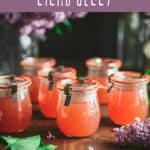
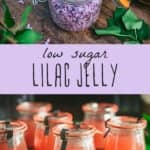
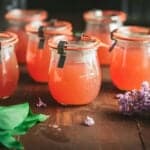

Do you ever use wax to seal the jars instead of canning?
No, that is no longer a safe canning practice.
Hi , about the lemon juice , is it better to use the “ReaLemon” brand lemon juice, the little plastic lemon you get at the store or a real fresh fruit lemon and collect my own juice???? What are you doing ?
Hi Jackie. You’ll want to use bottled lemon juice because fresh doesn’t have a consistent pH necessary for safe canning.
Can you freeze the flowers? Use later, when you have a bit more time. Not necessarily for this recipe just a general question.
Hi Lisa. Yes, you can!
Could less lemon juice be used or is it strictly necessary?
The full amount of lemon juice is needed for this recipe.
I made lilac jelly yesterday, put in less sugar than called for in recipe. It set up well and has a lovely color (I added a few elderberries) — but it has a bitterness to it. I’m going to have to throw the whole batch out. So I went out and taasted the lilac flowers (which I should have done ahead of time), and indeed, after the first lovely lilac flavor, there is a bitter aftertaste. Is this normal, or do I have a different variety of lilac from the one you are using? The flowers are fresh and in full bloom, not old.
Hi Moriat. Yes, sometimes lilacs can have a slight bitterness that is thwarted by the addition of sugar.